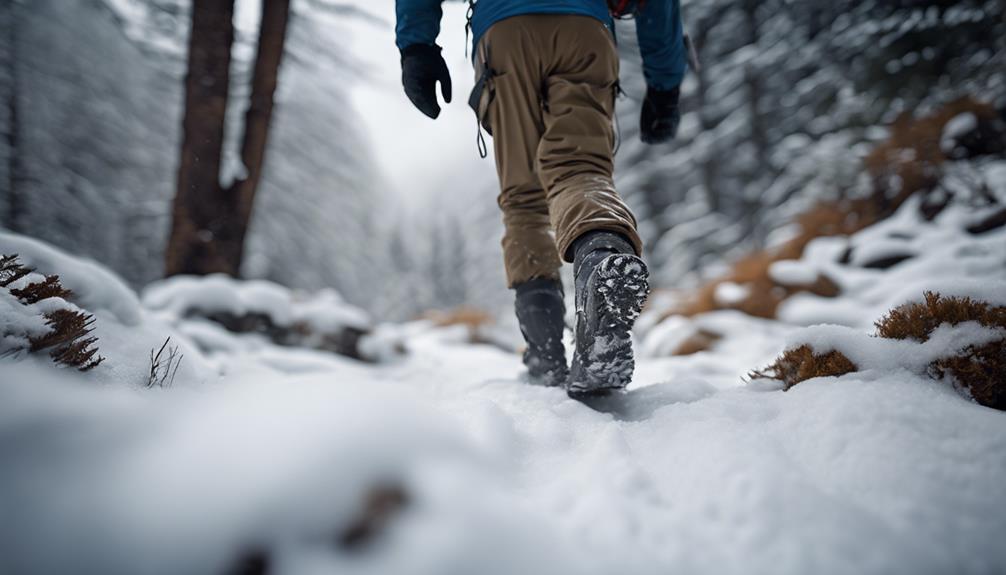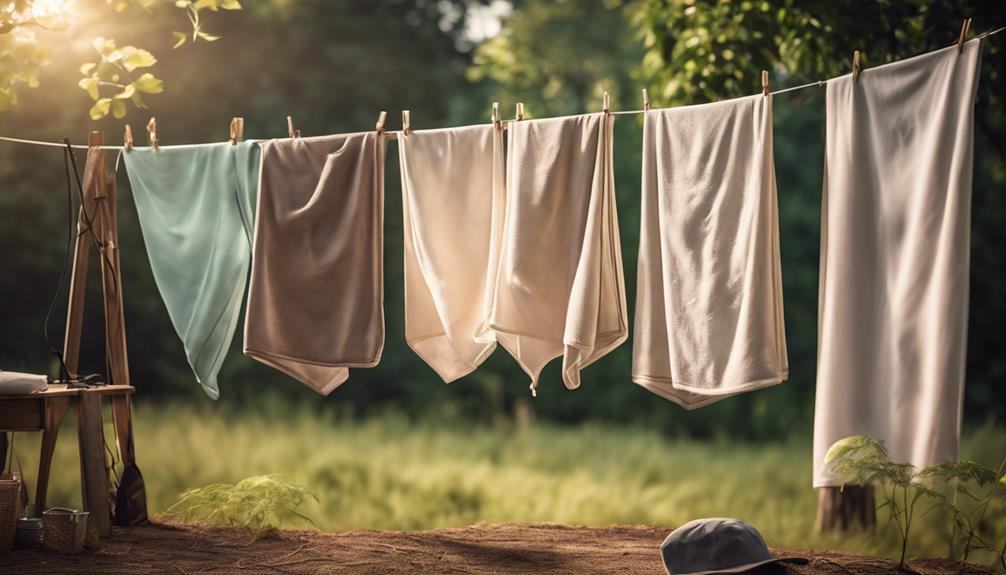
Looking for the perfect lightweight hydration pack? You want one that's comfortable, durable, and functional. The Osprey Skarab 18 is a great choice, known for its high comfort levels and durability.
If weight distribution and storage are your top priorities, check out the CamelBak M.U.L.E. Another contender is the Gregory Nano 18, offering a lightweight design with plenty of storage space.
When it comes to key features, look for packs that distribute weight evenly, use breathable materials, and provide easy access to water. Brands like CamelBak, Osprey, and Salomon are well-known for their quality in this category. Customizable straps and ergonomic designs can enhance your overall experience.
To find the ideal hydration pack that suits your needs, keep exploring maintenance tips and selection criteria.
Top Picks for Hikers
When you're looking for a hydration pack for your hiking adventures, you want one that's not only functional but also comfortable and durable. The Osprey Skarab 18 ticks all these boxes with its high comfort level and long-lasting resilience, making it a top choice for those who love the great outdoors.
Another popular option is the CamelBak M.U.L.E., known for its balanced weight distribution and ample storage capacity, perfect for day-long hikes.
If you prefer a lightweight design without sacrificing comfort, the Gregory Nano 18 is a great option, offering plenty of storage space.
All these packs are designed to provide reliable hydration, comfort, and durability on the trails. They feature smart weight distribution systems that help reduce strain and make your hiking experience more enjoyable.
Whether you value freedom or efficiency on your hikes, these hydration packs have got you covered.
Key Features to Consider
When choosing the best lightweight hydration pack, it's crucial to consider a few key features that impact its performance and suitability.
First off, you'll want to make sure that the weight distribution is even, so the pack feels balanced and doesn't strain your back while you're on the move. Opt for materials that are breathable to prevent overheating and maximize comfort, especially during longer excursions.
Easy access to water is a must-have feature, allowing you to stay hydrated without any hassle.
Moreover, it's essential to check the storage capacity of the hydration pack to ensure it can accommodate not only your water but also other essentials like snacks and tools.
Adjustable straps and fit are also important aspects to consider, as they allow the pack to conform to your body shape, providing optimal freedom of movement and overall comfort.
Best Brands Reviewed
When it comes to lightweight hydration packs, a few top brands have built solid reputations for their innovative and durable designs that enhance outdoor adventures.
CamelBak, for instance, stands out for its excellent weight distribution and ergonomic design, making it a top choice for passionate hikers.
Osprey offers similar perks, with the bonus of ventilated back panels that boost comfort during long treks.
Salomon, on the other hand, is known for its sleek and functional designs, offering minimalist options that don't skimp on usability.
All these brands prioritize the balance between weight and utility, ensuring users can fully enjoy their outdoor pursuits without feeling weighed down.
User Experience Insights
When considering a lightweight hydration pack, delving into user experience insights offers valuable practical benefits. Real-world feedback sheds light on crucial aspects such as comfort, durability, storage capacity, and weight distribution. Users consistently highlight the following advantages:
- Enhanced Mobility: Lightweight packs allow for unrestricted movement during various activities.
- Optimal Comfort: Customizable straps and ergonomic designs cater to individual comfort preferences.
- Durability: Premium materials ensure long-lasting performance, even in challenging conditions.
- Efficient Weight Distribution: Well-balanced loads reduce strain and enhance overall endurance.
- Adequate Storage: Multiple compartments provide ample space for essentials without adding unnecessary bulk.
These insights serve as a compass in choosing the ideal hydration pack that suits your thirst for freedom and adventure, offering a harmonious blend of functionality and comfort for your escapades.
Maintenance and Care Tips
Taking good care of your lightweight hydration pack is key to keeping it in top shape for all your outdoor adventures. To clean it, simply rinse the reservoir with warm water and mild soap, making sure to dry it thoroughly to prevent mold growth.
For a deeper clean, use a brush kit to scrub away any stubborn dirt or residue. When storing your pack, choose a cool, dry spot away from direct sunlight, and always leave the reservoir open to air out properly.
In case of minor leaks, a patch kit can come in handy to quickly fix the issue. For more significant damages, it's best to reach out to the manufacturer for replacement parts.
Keep a close eye on the bite valve and tubing for any signs of wear and tear, replacing them as needed to ensure optimal performance. By staying on top of maintenance tasks, you can rely on your hydration pack to quench your thirst whenever you hit the trails.
Frequently Asked Questions
How Much Water Should a Hydration Pack Hold for a Day Hike?
For a day hike, you'll want your hydration pack to hold around 2 to 3 liters of water. This amount is just right to keep you well-hydrated throughout your adventure, allowing you the freedom to explore without worrying about running out of water.
Are There Hydration Packs Designed Specifically for Women?
Absolutely, hydration packs designed specifically for women are available in the market. These packs are crafted with women's unique needs in mind, offering tailored sizing and ergonomic features to ensure a comfortable and high-performance experience. With these specialized hydration packs, women can embark on their outdoor adventures with ease and confidence, knowing that they have the right gear to support them along the way.
Can Hydration Packs Be Used for Activities Other Than Hiking?
Hydration packs are like the Swiss Army knives of outdoor gear. They're not just for hiking; they're perfect for a range of activities like cycling, running, skiing, and snowboarding. Imagine having easy access to water while you're on the move, without having to fumble with water bottles. It's all about convenience and keeping you hydrated as you enjoy your outdoor adventures.
Whether you're biking through rugged trails, hitting the pavement for a long run, shredding down snowy slopes, or gliding through fresh powder, hydration packs have your back. They give you the freedom to stay hydrated without interrupting your flow. No need to pause and reach for a water bottle when you can sip on the go with a hydration pack strapped to your back.
What Materials Are Hydration Packs Typically Made From?
Hydration packs are usually crafted from tough materials like ripstop nylon, polyester, and TPU (thermoplastic polyurethane). These materials ensure that hydration packs are sturdy while still being lightweight, providing convenience and dependability for a variety of activities.
How Do I Prevent Water From Freezing in My Hydration Pack?
To keep your water from freezing in your hydration pack while winter hiking, try these simple insulation methods. Insulated reservoirs are a great option to maintain the temperature of your water and prevent it from turning into ice. Thermal tube covers can also be helpful in shielding the tube from the cold and keeping the water flowing smoothly.
Another effective way to ensure your water stays liquid is by storing the hydration pack under your clothing layers. This will help to trap your body heat and maintain a warmer environment around the pack, reducing the risk of freezing. By keeping the pack close to your body, you can prevent the water from turning into an ice block during your outdoor adventures.
Conclusion
When it comes to picking out the best lightweight hydration pack for your outdoor adventures, there are a few key things to keep in mind. Factors like capacity, weight, comfort, and durability play a significant role in making the right choice. Popular brands such as CamelBak, Osprey, and Salomon offer top-rated options that cater to a variety of needs.
User feedback consistently emphasizes the importance of a well-fitted and easy-to-maintain hydration pack. Ensuring a proper fit and taking good care of your pack can significantly extend its lifespan and ensure it performs reliably on all your hikes.
Making an informed decision based on these criteria will undoubtedly enhance your hiking experiences. So, take the time to research and find the lightweight hydration pack that best suits your needs, and get ready to hit the trails with confidence.
- Discover the 4 Must-Have Camping Tent Accessories for Spring 2025 - March 19, 2025
- Why Camping Is Bad - November 29, 2024
- Best Camping Knife - November 29, 2024






